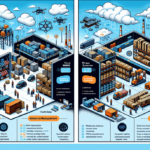Introduction to Warehouse Management Systems
Warehouse management systems (WMS) are essential for businesses handling physical inventory. They streamline operations, enhance accuracy, and improve efficiency. This article compares two prominent WMS options: SAP Extended Warehouse Management (EWM) and Fishbowl Inventory. We will examine their features, benefits, costs, ease of use, customer support, and more to help you decide which system best suits your business needs.
SAP Extended Warehouse Management (EWM)
Overview
SAP EWM is a robust and comprehensive warehouse management system that’s part of the SAP Supply Chain Execution Suite. Designed for large enterprises, SAP EWM automates and optimizes warehouse operations across various industries, including healthcare, food, and pharmaceuticals. It provides real-time visibility into inventory levels, shipment tracking, and resource management, allowing managers to make informed decisions rapidly.
Features and Benefits
- Advanced stock management and optimization functionalities
- Multi-level picking strategies
- Detailed inbound and outbound processes
- Optimization of material flows and resource utilization
- Automation of processes and reduction of manual labor
- Real-time visibility and tracking of inventory levels
- Integration with other SAP Supply Chain Execution systems
SAP EWM offers sophisticated analytics and reporting capabilities, enabling businesses to identify improvement areas and enhance operational efficiency. Its ability to manage complex warehouse structures, such as high-bay warehouses and automated storage systems, ensures optimal space and resource usage, leading to faster and more accurate order fulfillment.
Fishbowl Inventory
Overview
Fishbowl Inventory is an inventory management system tailored for small and medium-sized businesses. It provides real-time tracking of inventory levels, order management, manufacturing management, and asset tracking. Fishbowl's modular approach allows businesses to purchase only the modules they need, making it a flexible and cost-effective solution.
Features and Benefits
- Real-time tracking of inventory levels and orders
- Integration with popular accounting systems like QuickBooks
- Barcode scanning and mobile access
- Automated reordering of products
- Customizable reports and dashboards
- Simple and easy-to-use interface
- Multi-location tracking of inventory
- Advanced inventory forecasting and planning tools
Fishbowl Inventory’s integration capabilities with software such as QuickBooks and Salesforce streamline business operations and minimize manual data entry. Its user-friendly interface and mobile access features make it accessible for teams without extensive technical expertise, enhancing overall productivity.
Comparative Analysis: SAP EWM vs Fishbowl Inventory
Key Differences
While both SAP EWM and Fishbowl Inventory serve the purpose of inventory management, they differ significantly in complexity and scope. SAP EWM is designed for large enterprises with intricate warehouse operations and high-volume inventory needs, offering extensive customization and integration with other SAP modules such as SAP ERP and SAP S/4HANA. In contrast, Fishbowl Inventory caters to small and medium-sized businesses, focusing on essential inventory tracking and order management with limited customization options.
Cost Comparison
SAP EWM tends to be more expensive due to its advanced features and extensive customization options. Implementation costs for SAP EWM can range from $100,000 to $500,000, depending on the project's scope. On the other hand, Fishbowl Inventory offers a subscription-based pricing model starting at approximately $4,395 per user per year, making it a more affordable option for smaller businesses.
However, it's important to consider the total cost of ownership, including maintenance, training, and potential scalability needs. According to Gartner's report, the ROI on advanced WMS like SAP EWM can be substantial for large operations due to efficiency gains and error reduction.
Ease of Use
SAP EWM's sophisticated functionalities require significant training and expertise, making it more complex to use effectively. Its interface is less intuitive compared to Fishbowl Inventory, which offers a user-friendly and straightforward interface suitable for users with minimal technical background.
Fishbowl Inventory, with its intuitive design, allows businesses to quickly onboard staff and reduce downtime associated with training, which is particularly beneficial for smaller teams.
Implementation Process
Implementing SAP EWM involves a lengthy and resource-intensive process, often taking several months and requiring dedicated IT teams. This includes system configuration, customization, data migration, and extensive testing to ensure seamless integration with existing systems.
In contrast, Fishbowl Inventory can be set up within days or weeks, providing a quicker return on investment for businesses seeking immediate inventory management solutions. Its modular setup allows for phased implementation based on business priorities.
Customer Support
SAP EWM provides comprehensive customer support, including 24/7 assistance, training resources, and personalized on-site support for complex issues. This ensures that large enterprises can maintain uninterrupted operations and quickly resolve any challenges.
Fishbowl Inventory offers a knowledge base, community forums, and phone support during business hours. While adequate for small to medium-sized businesses, the support may not be as extensive or immediate as what SAP offers.
User Reviews and Ratings
User feedback for SAP EWM highlights its advanced capabilities and optimization features, though some users find the system overly complex and challenging to navigate. According to Capterra reviews, users praise the system's robustness but cite the steep learning curve as a drawback.
Fishbowl Inventory is praised for its ease of use and affordability, but some users note limitations in handling more complex inventory operations. Reviews on G2 highlight its user-friendly interface, though some express a need for more advanced features as their businesses grow.
Pros and Cons
Below are the advantages and disadvantages of each system to help you make an informed decision:
Pros of SAP EWM
- Advanced and comprehensive functionalities
- Optimization of processes and resources
- Real-time visibility and tracking of inventory levels
- Integration with other SAP Supply Chain Execution systems
- Excellent customer support
Cons of SAP EWM
- Expensive implementation and maintenance costs
- Complex and challenging to use
Pros of Fishbowl Inventory
- Easy to use and intuitive interface
- Real-time tracking of inventory levels and orders
- Integration with popular accounting systems like QuickBooks
- Affordable subscription-based pricing
- Good customer support
Cons of Fishbowl Inventory
- Limited functionalities for more complex operations
- Less optimization capabilities compared to SAP EWM
Final Verdict: Choosing the Right System for Your Business
The decision between SAP EWM and Fishbowl Inventory ultimately depends on the size, complexity, and specific needs of your business. Large corporations with extensive warehouse operations and complex inventory management requirements may benefit from SAP EWM’s advanced features and integration capabilities. On the other hand, small to medium-sized businesses seeking a cost-effective and user-friendly inventory management solution may find Fishbowl Inventory to be a better fit. Carefully assess your business needs, budget, and technical expertise before making a choice.




















